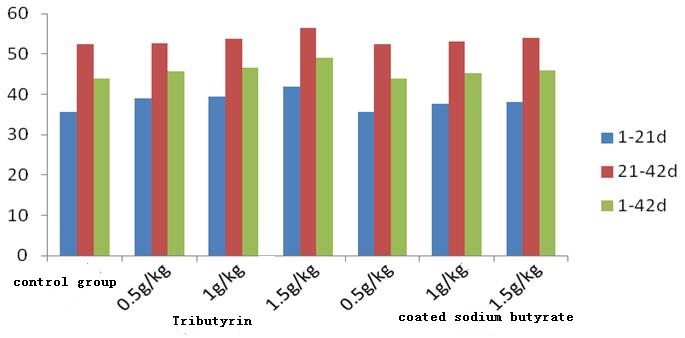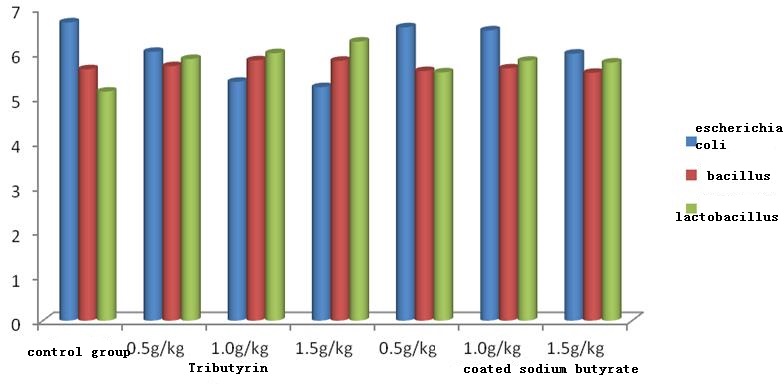Tributyrin For Bowel Health, Comparetion with Sodium Butyrate
Tributyrin is produced by Efine company based on the physiological characteristics and nutritional regulation of intestinal mucosa technology research of a new type of the animal health care products, can quickly replenish the nutrition the animal intestinal mucosa, promote the development and mature of bowel mucosa, repair all kinds of stress caused by intestinal mucosa damage, protect the intestinal health, strengthen the function of intestinal digestion and absorption, It can effectively prevent necrotizing enteritis and improve the production performance of livestock and poultry.
|
Product name |
tributyrin |
|
Appearance |
Off-white powder |
|
Main components |
Tributyrin , Glycerin monobutyrate agent |
|
odour |
No special odour |
|
particles |
100% pass 20 Target screening |
|
Loss on drying |
≤10% |
|
Packing specification |
Net weight 25kg |
Mechanism of action of butyric acid
Most of the fatty acids required by livestock and poultry can be obtained from food (feed), but some short-chain fatty acids (such as butyric acid) are not generally available from feed. Short-chain fatty acids, especially butyric acid, play an important role in maintaining intestinal health of livestock and poultry, including:
1.Butyric acid is a fast energy source for intestinal injury repair of livestock and poultry, which can rapidly decompose and release energy, promote the growth of chorionic membrane, and improve the body’s barrier function
2.Butyric acid can reduce the content of oxygen in the intestinal tract, inhibit the reproduction of harmful bacteria that consume oxygen, and promote the proliferation of beneficial bacteria such as lactic acid bacteria.
3.Butyric acid can activate active signal molecules of intestinal immune cells and improve intestinal mucosal immunity.
Sources and comparison of butyric acid in feed
The metabolic process of butyric acid in animals
Efficacy and characteristics
1.As the main respiratory fuel for intestinal epithelial cells, it can rapidly supply energy to intestinal epithelial cells, effectively promote the growth of intestinal mucosal cells, participate in the maintenance and repair of intestinal mucosa, and maintain the integrity and function of intestinal mucosal cells.
2.The intestinal villus height was increased, decreased crypt depth , improve the ratio of intestinal villus height to crypt depth , and improve the morphological structure of small intestine.
3.Reduce intestinal pH, inhibit the growth of pathogenic bacteria such as Escherichia coli, Salmonella and Clostridium perfringens, promote the proliferation of beneficial bacteria of lactic acid bacteria, regulate the intestinal microecological balance of livestock and poultry
4.Promote the secretion of antibodies and immune cell proliferation of intestinal mucosa, enhance the anti-stress and immune ability of livestock and poultry, reduce the occurrence of intestinal inflammation and other diseases.
Picture 1 Effects of triglyceride and Coated sodium butyrate on daily gain of white-feathered broilers
The results showed that compared with the control group, the daily gain of white feathered broilers was significantly increased by adding tributyrin , and the result was better than that of coated sodium butyrate group
picture 2 Effects of triglyceride and coated sodium butyrate on intestinal microflora of broilers
The results showed that compared with the control group, adding Tributyrin could significantly reduce the number of escherichia coli in the intestinal tract of broilers, and significantly increase the number of lactic acid bacteria, and the effect was better than that of coated sodium butyrate group.
Effects of triglyceride and sodium butyrate on growth and Diarrhea rate of Piglet
The results showed that, similar to the results of antibiotics, triglyceride could significantly increase the daily gain of piglets by 11% ~ 14%, decrease the ratio of feed to meat by 0.13 ~ 0.15, and significantly reduce the diarrhea rate of piglets, which was significantly better than sodium butyrate group.
Recommend usage :
| Feed animal | Recommend additive amount (48% powder ) | Recommend additive amount (90% liquid ) |
| Poultry |
500-1000g/T |
200-400g/T |
| Livestock |
500-1500g/T |
200-600g/T |
| Aquatic |
500-1000g/T |
200-400g/T |
| Ruminate |
500-2000g/T |
200-800g/T |

